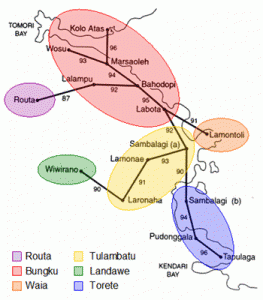History
Bungku, along with Banggai and Konawe (Tolaki), was formerly one of the principal kingdoms of Sulawesi’s eastern seaboard. For centuries Bungku was subject to Ternate, and at one time served as the principal source of iron implements for their Ternatean overlords (Tiele 1879:25; Bosscher and Matthijssen 1854:65–89).
Dialects
Based on a survey which visited the Bungku area in 1989, Mead (1999:48 ff.) reported extensive dialect chaining in the Bungku area and recognized six dialects (or seven, if one includes the extinct Epe dialect).

In this figure nodes are locations where word lists were collected, numerical values are percentages of shared basic vocabulary (‘lexical similarity’) between two word lists, and colored circles represent dialect areas. Geography is only approximately maintained. The prestige dialect, colored red, is that spoken in the former capital, also known as Bungku.
Population
Based on national census data for the year 2000, Indonesia Pelangi Nusantara (2010:139) reports 35,000 Bungku. However, subtracting Menui from this total—politically and culturally the Menui relate closely to Bungku, but linguistically their language is a dialect of Wawonii—suggests 27,500 as a more accurate estimate of the number of Bungku speakers.
References
Bosscher, C.; and P. A. Matthijssen. 1854. Schetsen van de rijken van Tomboekoe en Banggai, op de Oostkust van Celebes. Tijdschrift voor Indische Taal-, Land- en Volkenkunde 2:63–107.
Indonesia Pelangi Nusantara. 2010. Profil doa suku-suku yang terabaikan. Jakarta: IPN.
Mead, David E. 1999. The Bungku-Tolaki languages of south-eastern Sulawesi, Indonesia. (Pacific Linguistics, D-91.) Canberra: Australian National University.
Tiele, P. A. 1879. De Europeërs in den maleischen Archipel, tweede gedeelte: 1529–1540. Bijdragen tot de Taal-, Land- en Volkenkunde van Nederlandsch-Indië 27:1–69.